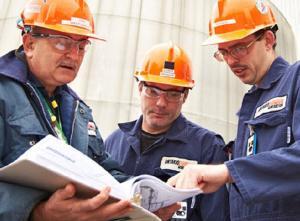
Ontario Writes the Playbook for its Nuclear Refurbishment
 Ontario is preparing to refurbish 10 of its 18 nuclear reactors, beginning at the end of this year. This investment will extend the lives of the reactors, keeping their operation safe and effective for decades to come. It will also create thousands of jobs and inject much-needed dollars into Ontario’s economy. The project comes in at half the cost of building new reactors – and is considerably cheaper over the long term than investing in solar, wind, or gas for a similar amount of power.
Ontario is preparing to refurbish 10 of its 18 nuclear reactors, beginning at the end of this year. This investment will extend the lives of the reactors, keeping their operation safe and effective for decades to come. It will also create thousands of jobs and inject much-needed dollars into Ontario’s economy. The project comes in at half the cost of building new reactors – and is considerably cheaper over the long term than investing in solar, wind, or gas for a similar amount of power.
As Ontario Energy Minister Bob Chiarelli said in an interview with Global News, “The best cost deal in replacing the existing nuclear is to refurbish what we have.”
That said, refurbishment still comes at a cost: about $25 billion for the 15-year project. So, Ontario’s Long-Term Energy Plan for 2013, which announced the government’s decision for refurbishment, set out seven principles for the refurbishment – and everyone involved in it.
“Minimize commercial risk on the part of ratepayers and government”
The people and government of Ontario are making a large investment in nuclear power. They should receive the expected return on that investment without a great risk of having to invest further. The other six principles follow from this one.
“Mitigate reliability risks by developing contingency plans that include alternative supply options if contract and other objects are at risk of non-fulfillment”
Ontario has a diverse power mix. Electricity comes mainly from nuclear power, but hydro, renewables, and gas also play important roles. The province can also buy power from other provinces or states. So, while the Long-Term Energy Plan recognizes the refurbishment of nuclear power plants as the best long-term option, the province will also look at investing in these alternatives. Ontario’s recent agreement to share electricity with Quebec at certain times of the year may create more flexibility for the province.
“Entrench appropriate and realistic off-ramps and scoping”
One way of holding the operators and contractors to account involves “off-ramps” – contract terms that allow the province to limit or stop the project if it goes over budget.
“Hold private sector operator accountable to the nuclear refurbishment schedule and price”
As the private-sector operator involved in the refurbishment project of the Bruce power plant, Bruce Power must ensure that the refurbishments stay on schedule and within budget; the company will not be in a position to simply pass additional expenses on to ratepayers.
“Require OPG to hold its contractors accountable to the nuclear refurbishment schedule and price”
Likewise, Ontario Power Generation (OPG) is contracting much of the refurbishment at the Darlington station to more specialized companies. A slowdown or cost overrun for any one of them could affect the overall timeline and budget. So, these companies are being held accountable as well.
“Make site, project management, regulatory requirements, and supply chain considerations and cost and risk containment, the primary factors in developing the implementation plan”
Robust project management is at the core of the refurbishment project. For example, at Darlington, OPG did an environmental assessment, which showed that the refurbishment would not have any significant adverse environmental effects. A safety review also demonstrated that the Darlington plant meets modern codes and standards and follows sound industry practices. Safety improvements recommended by both these assessments are now part of the Darlington Integrated Implementation Plan. Finally, an overall risk assessment demonstrated that Darlington is a safe and reliable power plant, and will continue to be after planned safety improvements. Similar measures are underway at the Bruce facility.
“Take smaller initial steps to ensure there is an opportunity to incorporate lessons learned from refurbishment including collaboration by operators”
The refurbishment project will begin with two reactors – one each at the Bruce and Darlington facilities. Through the 15 years of the project, no more than three reactors are planned to be under refurbishment at any one time. This will provide opportunities to assess each refurbishment, learn from it, and apply those lessons to the next ones.
Even the first refurbishments will benefit from experience – such as refurbishments at Bruce Power, at Point Lepreau in New Brunswick, and at the Wolsong 1 reactor in South Korea. OPG has also created a full-scale replica of the Darlington reactor vault for testing tools, training, and ensuring that the teams can coordinate in real time.

